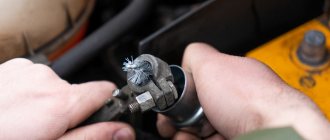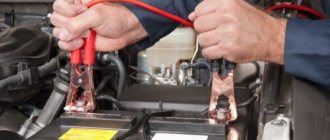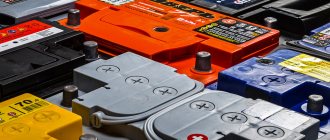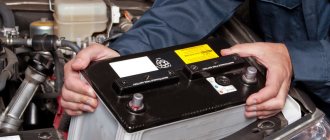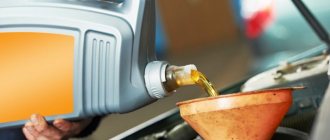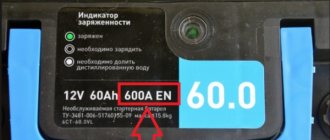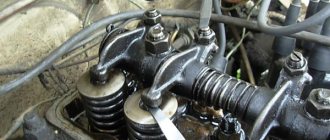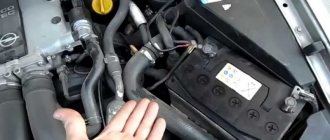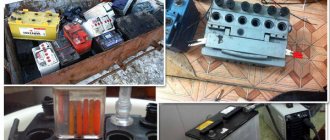The battery is an important and critical element in any car. At the same time, the service life of the battery is limited and depends on a number of factors and features. As a rule, the “health” of the battery is directly related to the quality of the generator (charging the battery), as well as the general condition of the wiring (leaks and self-discharge) and the engine (battery discharge when trying to start the engine).
It should also be noted that the life of a car battery is also influenced by the environment in which it is located, as well as the regularity and quality of maintenance of the car battery. In this case, maintenance involves not only monitoring the charge and charging the battery with an external charger if necessary, but also checking the level and density of the electrolyte, as well as the general condition of the solution in the battery “jars”.
In turn, cleaning the terminals is also a necessary procedure, since if it is necessary to service the battery, care, cleaning and assessing the condition of the terminals is a recommended and responsible procedure. Simply put, even if everything is in order with the battery and generator, but the battery terminals oxidize, the battery will actively wear out and quickly fail. Next, we will look at how to clean the battery and its terminals.
Battery terminals: when to clean the battery terminals
So, most car owners are well aware that contact oxidation is a fairly serious problem, especially when it comes to the battery. A characteristic white coating may indicate the beginning of the oxidation process. However, such plaque may not always actively form and be noticeable to the naked eye.
It also happens that no oxides are visible, but the overall process of battery oxidation is still in full swing. An oxidized car battery terminal results in the following:
- when starting the internal combustion engine, the voltage in the on-board network drops;
- active self-discharge of the battery is noted;
To more accurately check whether oxidation is occurring, if there is no white coating on the terminals, you need to prepare a 10% soda solution (add 2 tablespoons of soda to 200-250 milliliters of distilled water). The battery terminals are slightly moistened with the resulting solution.
In the event that oxidation of the terminals occurs, the solution will neutralize the remaining electrolyte. In this case, you can notice the boiling of the applied solution. If so, boiling will clearly indicate that the battery terminal is oxidizing and the battery terminals need to be cleaned. Also, after cleaning, the battery terminals will need to be lubricated.
At the same time, it is a mistake to believe that just applying lubricant is enough. It is necessary to clean the terminals, and only then lubricate the terminals of the car battery. In order to perform cleaning correctly, you must take into account certain recommendations given below.
Ignition system care
High voltage wires, coils and distributors need to be kept clean. Wipe them periodically, without leaving “bridges” of dirt. Over time, moisture accumulates on them, which contributes to high voltage breakdown (up to 20,000 volts). After cleaning, spray the wires and covers with water-displacing spray.
It is worth noting that in a car with a contact ignition system for the “distributor slider”, a “zero” or a matchbox is the only cleaning option.
It is strictly not recommended to scrape the work surface with a knife.
How to clean battery terminals and how to do it correctly
First of all, you need to prepare the materials for cleaning. In practice, in a garage, oxidation is best removed with felt. With the help of felt, you can remove not too strong oxides quickly and gently; the felt itself resists acids well.
We also note that among the methods of further protecting terminals from oxidation, a method is practiced when felt gaskets soaked in oil are installed. In this case, felt will also come in handy. In addition to felt, you will also need at least a sponge, a toothbrush, and you will also need to prepare the soda solution mentioned above.
If the oxidation is too active and extensive, sandpaper (fine-grained) is needed. In this case, you need precisely fine grain so that abrasive residues do not remain on the surfaces.
You can also use brushes with metal bristles, special cleaners for terminals, or double-sided brushes such as brushes, etc. At the same time, the presence of a drill will speed up and facilitate the process, since manually using sandpaper or a brush will take longer and more difficult.
Please note that when working with a drill, a portable screwdriver with a brush attachment is best suited. In this case, cleaning the terminals is performed at medium speeds, without pressure. Cleaning must be done delicately, even if removing oxides will take more time.
- In any case, before purchasing this or that tool, it is important to determine how badly the battery terminals have oxidized. If the process has just begun, there is no white coating, then sandpaper, felt and a soda solution are enough.
If a layer of white residue is clearly visible, more thorough cleaning will be required. In this case, you can think about preparing brush attachments and a drill. Let us add that you can also find special special products for cleaning terminals and removing oxidation on sale. Such solutions are used both separately and in combination.
Also, don’t forget about special lubricant to protect the battery terminals. This lubricant must be applied after cleaning. Otherwise, the terminals will quickly oxidize again.
- Having prepared everything you need, you can move on to how to clean it if the battery terminals have oxidized. First of all, it is important to understand that oxidation must be removed as efficiently as possible. If this is not done, after superficial cleaning, after a while you will have to remove the white coating from the terminals again.
First of all, before the battery terminal itself is cleaned, it is necessary to clean the battery and inspect it for integrity. It happens that there are cracks near the terminals, that is, the electrolyte will cause re-oxidation of the terminals even after they are cleaned. In such a situation, it is better to change the battery immediately.
If everything is in order with the battery, you need to wipe the battery case from plaque, acid residues, dust and dirt. To remove dirt, use a weak soda solution and a rag. You can also clean the battery housing using engine wash cleaners.
We also recommend reading the article on how to desulfate a battery. From this article you will learn about the reasons why the battery begins to sulfate, as well as how to desulfate the battery yourself.
Having cleaned the outside of the battery, you can move on to removing oxidation products from the terminals themselves. It is important to understand that all work must be carried out in compliance with safety precautions (when removing the battery, do not forget that there is acid inside), and you should not exert any force when working in the area of the terminals themselves.
It is important to prevent accidental damage to the battery case, terminals, etc. It is also recommended to protect your eyes and breathing, wear gloves, and perform work in a ventilated area. After cleaning, rinse the terminals with distilled water.
Once you're done cleaning, you need to know how to lubricate the battery terminals to protect them. The freshly cleaned battery terminals are screwed in, after which they should be treated with the selected battery terminal lubricant. At this point, the process of cleaning and lubricating the terminals can be considered complete.
Why lubricate?
How to properly charge a gel battery? 2 ways: regular and special charger
There are several reasons here, but initially this is one reason, so:
- In order to improve the electrical contact of the circuit, there are lubricants that actually improve the transmission properties of electricity
- Perhaps the most important reason is its PROTECTIVE PROPERTIES. The thing is that lead (terminals are also made from it) tends to oxidize. Especially under the influence of the environment. Another disadvantage is that on old cars the terminals were made of copper, and the contacts were made of lead; various metals developed oxidation over time. Well, if you take old batteries that were serviced (made using antipyretic technology), then their electrolyte often boiled out of the cans, and quite violently. The fumes came along with some of the sulfuric acid, which could also get on the contacts. Here you go - OXIDATION AGAIN.
By the way, many auto electricians recommend treating the mass of the body with such protective compounds; it can also oxidize over time. Actually, so that nothing oxidizes these contacts and lubricates the terminals, if this is not 100% protection, then at least decay products do not appear for quite a long time.
Let's sum it up
As you can see, when servicing the battery, the battery terminal is the element that needs to be given special attention. In fact, precisely because of the oxidation of the terminals, even serviceable batteries can discharge on their own, poorly accumulate charge from the generator, have difficulty starting the engine, etc. Moreover, without cleaning, even attempts to charge the battery with external chargers may not give the expected result.
We also recommend reading the article on how to lubricate battery terminals. From this article you will learn why terminal lubrication is needed, as well as which lubricant is best to lubricate battery terminals.
The reason is that a fully charged battery after an active discharge when starting the internal combustion engine will not be able to renew the expended energy in full, even if the generator provides normal charging. As a result, problems with the battery will begin again after a short period of time without cleaning and lubricating the terminals.
For this reason, the information given above allows us to completely eliminate not the result of the problem itself, but its source, which is the oxidized terminals of the car battery. Also, correct selection and application of protective lubricant to the battery terminals will avoid the occurrence of similar malfunctions in the future and significantly extend the service life of the battery.
Half-incandescent lights
Another problem is oxidation of the rear light circuit boards.
, familiar to VAZ-2110 owners. When the turn signals are turned on, the headlights and brake lights begin to blink alternately. This lost “mass” is looking for a shortcut. To avoid problems, remove the connector, clean it with 800-1500 grit sandpaper, and treat it with a water displacer.
When installing additional equipment, make sure that the screws do not damage the electrical wiring cables. The worst option is a violation of the integrity of the CAN bus. The number of possible problems is difficult to imagine even for an experienced auto electrician.
Keeping your contacts clean is not at all difficult. This simple procedure will eliminate electrical problems and instill confidence in your car.
Reliable contacts and stable spark!
Topdetal.ru expert Ilya I.
Gentle cleaning methods
Many motorists have empirically found the most effective ways to clean battery terminals. It does not require any special physical effort. This problem can be solved with the help of improvised materials, household chemicals and even medicines.
Soda
When using a car over time, the terminals are corroded by the electrolyte that gets on them. This promotes the formation of rust and sulfates on the surface of the joints. To get rid of acid residues, it is recommended to use a soda solution, for the preparation of which you need to dissolve a tablespoon of soda in a glass of warm water.
You need to treat the terminals with a rag soaked in soda solution, and then wipe them dry. To remove copper sulfate, you will need a baking soda solution and a stiff brush.
Here it is important to generously treat the contacts with liquid, and then carefully brush the surfaces.
This procedure must be carried out in the following order:
- first remove the negative and then the positive cable from the battery;
- wrap the terminals with a cloth soaked in soda solution, lower the terminals on the wires inside the containers for about 20 minutes;
- remove rust on contacts;
- prepare a fresh soda solution and soak the terminals in it again;
- Clean the contacts with water, wipe with a damp cloth, and let dry.
Apply a small amount of Vaseline or other protective lubricant, connect the positive terminal first, and then the negative terminal.
Sandpaper, wire brush
White deposits on battery terminals are lead that has oxidized. To ensure better electrical conductivity, it is better to clean the metal of all oxides. In this case, a mechanical method is suitable. For this you will need regular coarse sandpaper.
To clean the battery contacts and terminals, you need to turn off the engine and disconnect the contacts. It is advisable to remove the key from the ignition switch.
The cleaning procedure itself is simple. You just need to clean the battery poles and terminals until they are shiny.
Gasoline
This method should be used with extreme caution, since gasoline, if it comes into contact with rubber or plastic elements, can corrode them. On the other hand, this type of automobile fuel copes well with oxides, destroying them to metal.
Here you need to soak a rag well and carefully rub the terminals and contacts of the battery until traces of corrosion and white deposits are completely removed.
The methods described above are the most effective and simple. Even a novice motorist can solve the problem using one of these methods.
It should be remembered that the popular WD-40 product is not very suitable here, since this composition contains conductive substances of an unknown nature. You also need to be careful when using acetone. This solvent even destroys metals.
Advantages and disadvantages of conductive compounds
- We have already looked at the strengths. Protection from external influences, reliable contact during vibration, easier opening of the connector (electrical conductivity has nothing to do with it, in any case it’s a lubricant). Another advantage is that the conductive paste in some cases can act as a separating layer between dissimilar metals. For example, when copper and aluminum are directly connected, an electrochemical reaction occurs and the metals rapidly corrode. A layer of paste reduces the negative impact. Application of lubricant for electrical contacts
- The disadvantages include the possibility of short circuiting. If the connector is tight enough, the paste may short out nearby contacts. It is clear that at high current values, the lubricant will simply evaporate: but a fire may also occur. In this case, a fuse will help. And if you close the low-current signal contacts, then in the best case, the electronic modules will not execute commands, and in the worst case, the element base will fail.
Therefore, conductive compounds are not applied like a layer of butter on a sandwich. The composition covers only the contacts, if possible without the formation of streaks and drops. Accordingly, it cannot be used on compact connectors with a dense comb.
Car contact cleaners and lubricants: which ones are better?
The most popular cleaners for oxidized machine contacts are 3 types.
- ABRO Electronic Contact Cleaner.
The product is used to clean electrical contacts. It is produced in aerosol packaging of 2 types: 163 and 283 ml. Perfectly removes dirt, fats, oils, does not destroy plastic.
- AVS Crystal Contact Cleaner.
A relatively cheap contact cleaner that gives good results after treatment. Removes moisture and dirt from car connectors. Neutral to rubber, plastic, painted surfaces. Available in stores in aerosol cans.
- Hi-Gear HG40.
One of the popular cleaners Source voditeliauto.ru
Quite an expensive product, but the price is justified because it effectively cleans the car’s contacts. It is produced in aerosol containers and has a convenient sprayer. In addition to cleaning, it forms a thin layer in the form of a protective film on the contact coating. This layer protects the surface from corrosion for some time. This improves the quality of the connection.
Causes of oxidation
For what reasons do oxidation processes occur at the terminals?
Oxide deposits are a wake-up call for the car owner to take the necessary measures. It is important to understand the reasons for the occurrence of oxide before stripping the terminals and processing.
Causes:
- In the absence of tightness and insufficient contact of the tip with the battery, the electrolyte evaporates, which causes oxidation.
- Mechanical damage to the terminal - if chipped or scratched, it is better to replace it.
- Lack of tightness at the terminal outlet.
- Overcharging of the generator is often caused by a disruption in the operation of the voltage regulator.
- No weight on the engine.
Litol
Since Soviet times, thick non-conductive lubricants have been used as the main means of protecting against corrosion:
- nigrol;
- grease;
- shahtol;
- lithol;
- inedible fat.
Currently, lithol continues to be relevant for protecting battery terminals due to its greatest efficiency. This fuel and lubricant has good penetrating properties, covering the area of metal surfaces of the contact zone with an insulating layer.
With natural wear and temperature changes, the physical state and qualities of lithol change and it hardens. Therefore, during the implementation of routine measures for cleaning the contacts (which are required twice a year), the remnants of the old lubricant are completely removed, after which a fresh one is applied.
Basic rules for applying lubricant to contacts
There are several points to consider when lubrication:
- the internal cavities of the connectors must be thoroughly cleaned of moisture, dust removed, and dried;
- clean contacts such as “male” with sandpaper (fine), removing sawdust;
- The female connectors are cleaned using a thin needle, a file, or a narrow emery strip.
Automotive connectors Source 12vt.ru2
